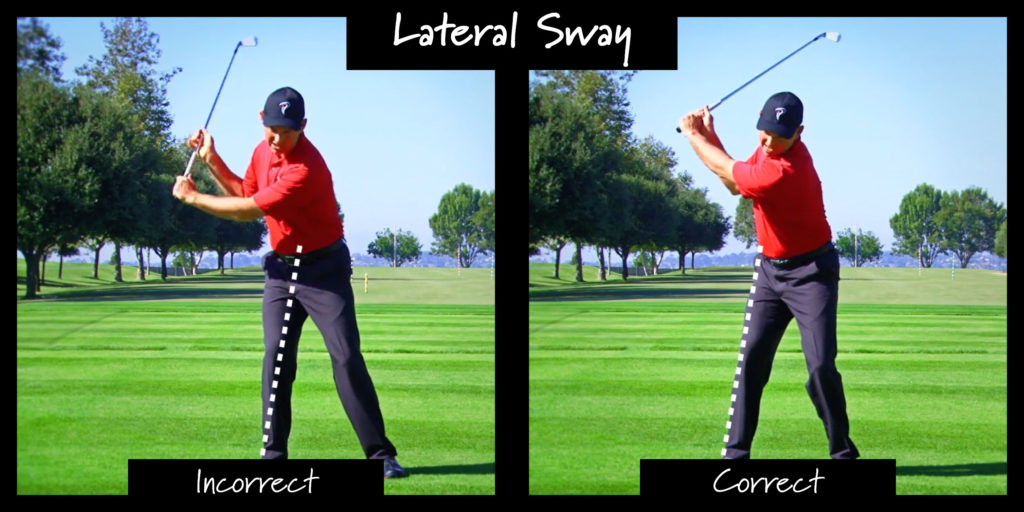“If they want you to cook the dinner, at least they ought to let you shop for some of the groceries.”
– Bill Parcells
When Bill Parcells said this, he was the coach of the New England Patriots. He was referring to how if the Patriots’ owner wanted him to be the coach of a great team, then he needed to have a say in the players on that team. This is one of my favorite quotes as I feel it is applicable to many different aspects in life, not just football. I interpret this quote as – to achieve optimal results, you need to make sure you are prepared and have certain resources available to you. Otherwise, when it comes time to cook dinner, you will be left with random ingredients that don’t fit together. Or worse, find out you are missing and lacking what is needed to prepare a great meal. This way of thinking can be applied to work situations, life situations, and for this article, golf.
A lot of us golfers love to go out and play, but we often wish we could play better (or not be as sore afterwards). Some of us even take lessons to get better. However, it is often difficult to find that consistency to get results. Sure, more reps and rounds of golf would help, but it often goes further than just more practice.
Sometimes, we just don’t have the right “ingredients” in our golf swing, making it extremely hard to produce a consistent and sound golf swing no matter how much you practice. You are asking your body to biomechanically do something it is not capable of doing. The golf swing is a complex rotational movement that requires all facets of the body to work together. If the body does not have the requisite mobility or stability at certain joints, the body will never be able to produce a repeatable golf swing and consistent results will be very hard to come by.
Even worse, not having the required mobility or stability at a joint means you are bound to compensate. Compensations will typically result in injury, especially with increased repetition. Therefore, not having the right “ingredients” in your golf swing not only is causing you strokes on the course, but also will very likely lead to injuries if it hasn’t already.
The Titleist Performance Institute (TPI), the premier leader in the biomechanics of the golf swing, has a great philosophy. They state, “we don’t believe there is one way to swing a club…but we do believe that there is one efficient way for everyone to swing a club and it is based on what they can physically do.” There are three things that lead to efficiency breakdowns.
- Poor golf mechanics
- Physical limitations
- Poor equipment.
Below, I will review the most common swing errors and their relation to specific physical limitations. By improving these physical limitations, you can then address the swing mechanics which will help produce a more consistent golf swing and thus, keep you healthy so that you can keep playing.
S-Posture
S posture is characterized by too much arch in the lower back. This causes the core and glutes to not be able to work properly. As a result, the lower body is out of position on the downswing, leading to loss of distance and excessive lumbar strain.
Possible reason:
- Tight back muscles (paraspinals) and tight hip flexors
- Weak core/glutesàpoor lumbar stabilization strategies
- Difficulty understanding a proper hip hinge position
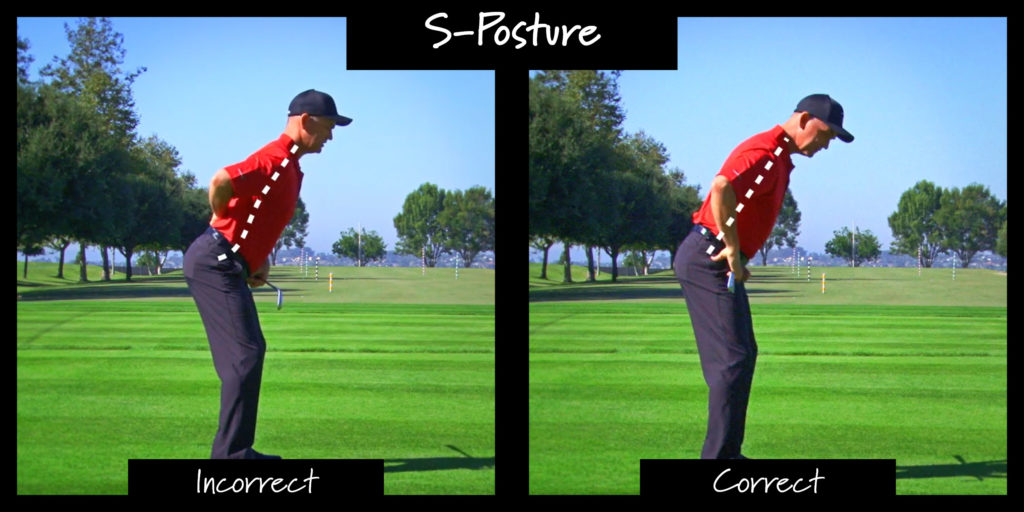
C-Posture:
Another postural limitation characterized by increased rounding of the upper spine (thoracic spine) and rounded shoulders. This position causes decreased thoracic rotation. As a result, either your backswing will be shorter and not be able to hit the ball very far, or more likely, you will compensate. A common compensation is to increase lower back rotation which will lead to lower back pain due to the excessive strain placed on this area. Another compensation is to have your arms get wide from the body to create more torque. This can lead to losing the plane of your swing and swinging outside in. This typically results in a slice/excessive fade or hitting behind the ball and hitting it fat.
Possible reason:
- Decreased thoracic extension mobility
- Tightness in the pecs, lats, upper traps, and neck muscles
- Weakness in the lower traps, serratus anterior and other postural stabilizers
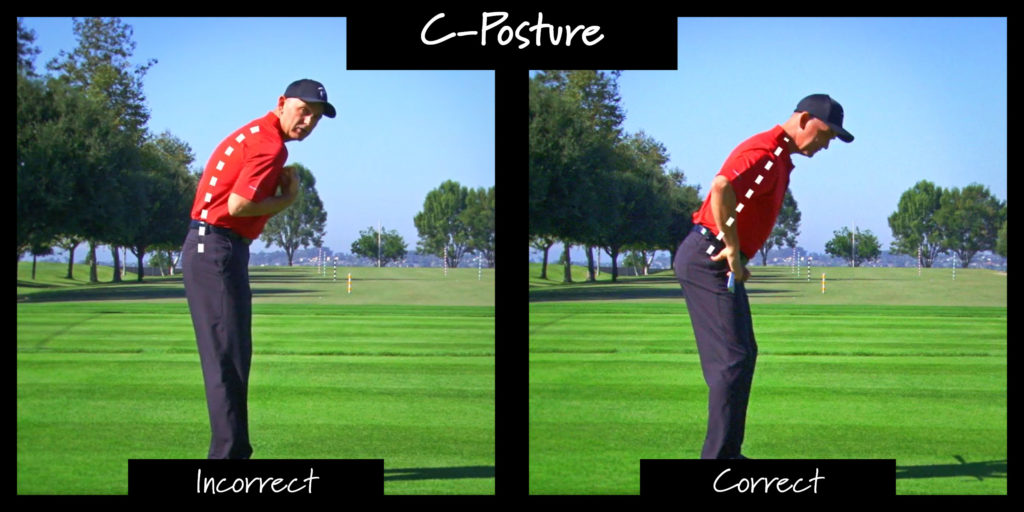
Loss of Posture:
Watch any professional golfer and they can keep the same spine angle throughout the entire swing. Whether it is the backswing or downswing, the spine stays incredibly still as the hips and shoulders rotate around the spine. The inability to do this causes you to either come out of your stance or lose your balance towards the golf ball. Your swing will get off plane and depending on which way you lose your posture, will result in hitting it thin (come out of your stance) or chunking it (collapse). If you cannot maintain your balance at the finish of your swing, you are probably not maintaining a consistent spine angle throughout the swing.
Possible reason:
- General shoulder and hip mobility restrictions (tight lats, hip flexors)
- Poor spinal stabilization and Inability to dissociate thoracic from pelvic rotation
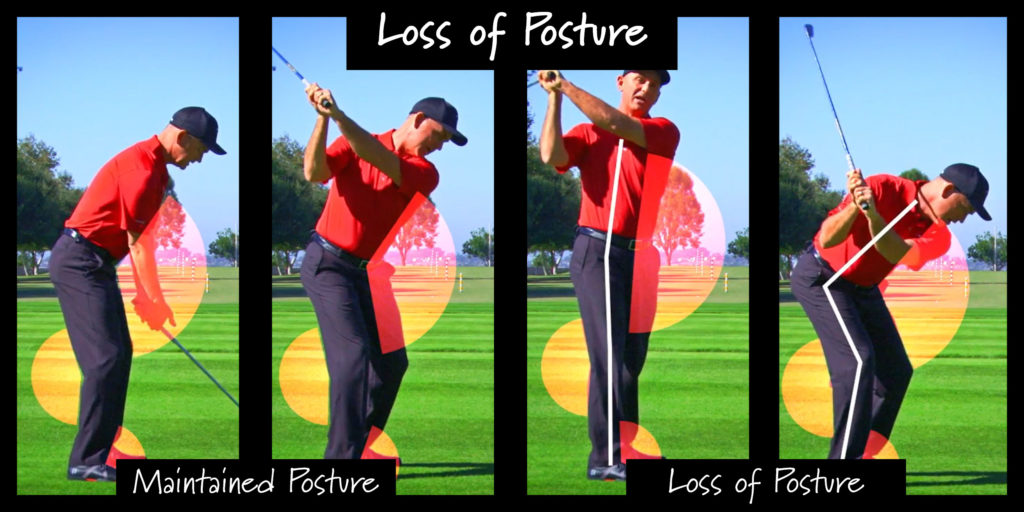
Flat Swing
The club at the top of a proper backswing should be at a 45˚ angle, and the shaft of the club should point within 4 feet of the golf ball. With a flat swing backswing, the club will be almost parallel to the ground. A flat backswing will usually lead to the club being out of position at impact causing a hook or poor contact.
Possible Reason:
- Poor shoulder mobility- decreased external rotation and abduction of the back arm. Decreased internal rotation and adduction of the front arm
- Decreased thoracic extension and decreased thoracic rotation
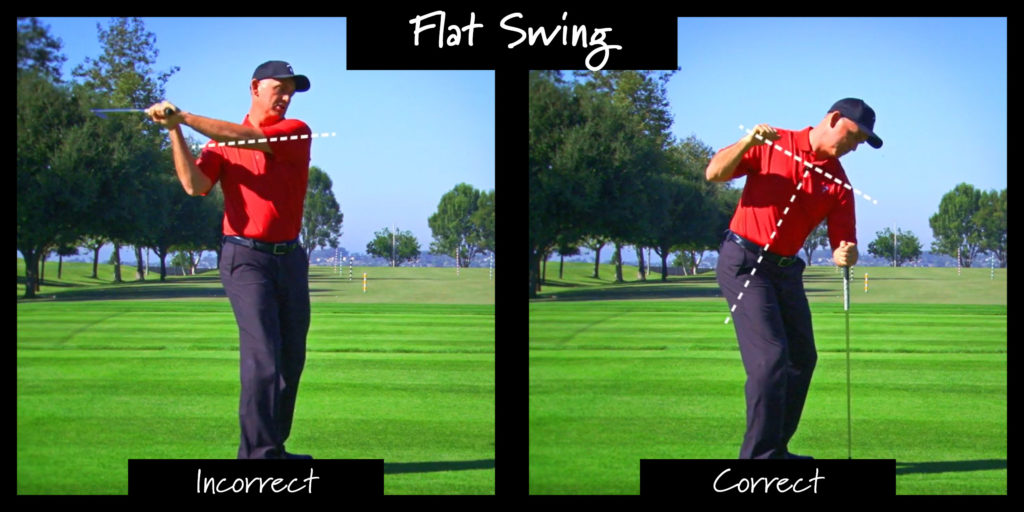
Too Steep Swing
The “Too Steep” swing is the opposite of the flat swing. The club is too vertical at the top of the backswing. This occurs when the lower body is not balanced and stable causing the upper body to initiate the swing, leading to an outside-in swing path and the typical fade/slice that a lot of golfers deal with. A steep swing also leads to inconsistent contact, as the club is coming in on such a steep plane there is less margin for error.
Possible Reason:
- Poor single leg balance-Can’t properly shift into back leg on backswing or can’t shift onto lead leg during downswing causes arms to become too active
- Poor core stabilization and inability to separate pelvic from trunk rotation causing upper body to rotate before it should on downswing
Coming Out of the Swing
“Coming out of the swing” refers to when the body is too vertical at impact. This characteristic is related to the loss of posture where you come up and out of the address posture. The hips and trunk will extend too early on downswing causing the arms to feel “stuck” and left behind, as decreased hip internal rotation causes compensations and the body to shift towards the ball. To make up for the shift towards the ball, the body stands up more vertically so the club can still make contact with the ball.
Possible Reason:
- Decreased hip internal rotation on front leg
- Poor ability to separate pelvic and thoracic rotation
- Weak core and glutes
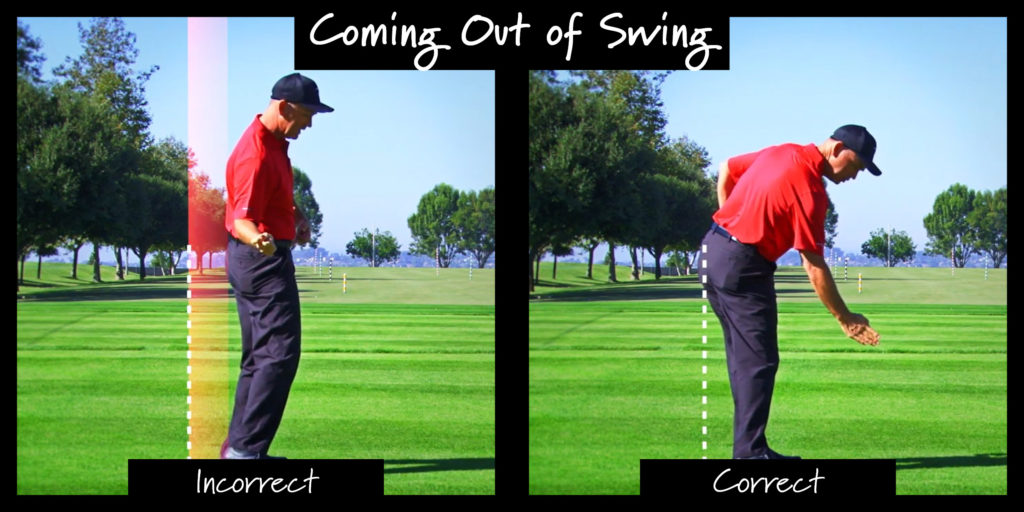
Reverse Spine Angle
This characteristic is the number one cause of lower back pain during golf. A reverse spine angle swing is defined by excessive upper body side bending toward the target during the backswing due to restricted back leg hip internal rotation. To make up for the limited hip mobility and to still get enough of a load to generate power into the downswing, the golfer will either sway or laterally trunk bend to compensate. This puts an excessive amount of strain on the lumbar spine. It also puts the hips into a poor position to clear during the downswing. As a result, the upper body moves too quickly, and the club and arms cast down. This can lead to hitting it fat, slicing it, or simply lower back pain.
Possible Reason
- Decreased hip internal rotation
- Decreased leg single leg balance
- S-curve posture
- Decreased ability to separate pelvic and thoracic rotation
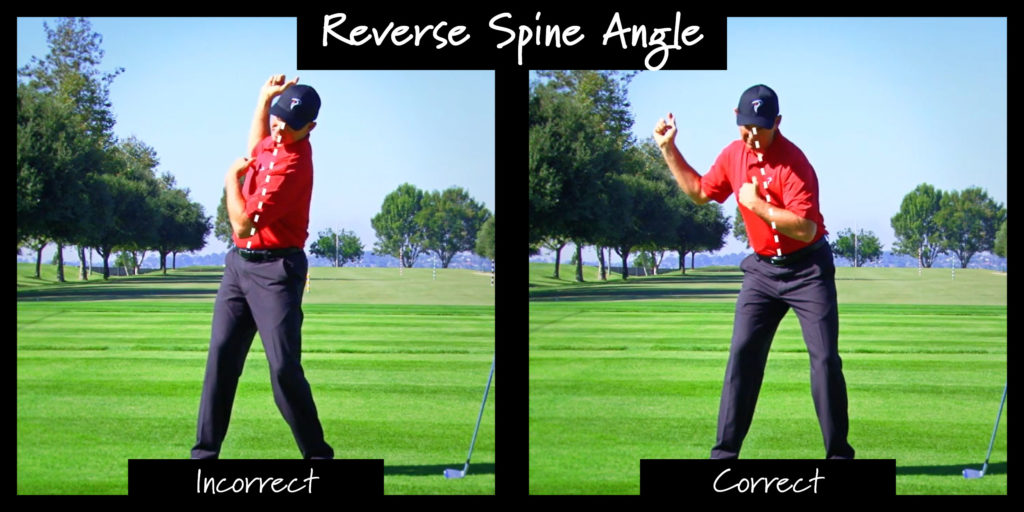
Lateral Sway in Backswing
Another common swing fault is where the body and hips shift and move sideways away from the target during the backswing. This is called lateral sway. Rather than turning in a rotatory movement to load during the backswing, the golfer loads by shifting sideways. This makes it much harder to transition from the backswing to the downswing and prevents shifting weight onto the lead leg during the downswing. As a result, the body gets “stuck” leading to fat shots and an outside-in swing path that leads to slices. The head is also forced to move making it tougher to make consistent contact as now you are trying to hit something while your head and eyes are not fixed.
Possible Reason:
- Decreased back leg hip internal rotation mobility
- Poor lateral trunk and hip stabilization
Lateral Slide in Downswing
A lateral slide is similar to lateral sway but occurs during the downswing where the body and hips move and shift sideways toward the target. The body doesn’t properly rotate around and all weight transfer from back to front leg is lost. This results in a loss in distance. The arms can again get stuck behind the body causing a fat shot or an outside-in path leading to a slice/big fade. The head may also move, once again making it more difficult for good consistent contact.
Possible Reason:
- Decreased front leg hip internal rotation (lower quarter rotation test)
- Poor lateral trunk and hip stabilization (single leg balance and SL bridge tests)
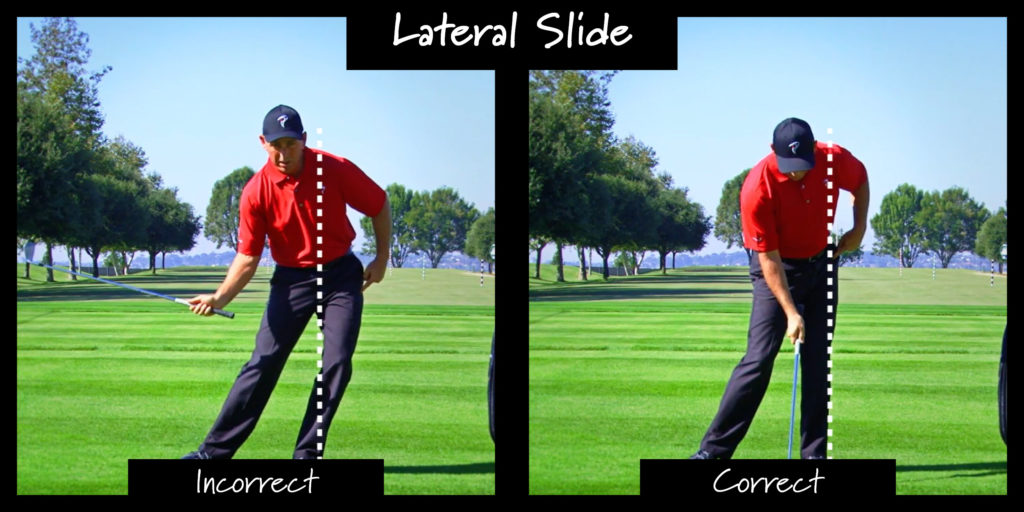
As can be seen, there are a multitude of ingredients needed in the golf swing. At Excel, your physical therapist will be able to evaluate you to determine which areas need attention and focus. Your therapist will be able to create a comprehensive and customized program through hands on treatment and corrective exercises to improve these areas in order to optimize your body’s movement capabilities. Better movement means a more consistent swing, less compensations, and a healthier body that can withstand the demands of the golf swing repeatedly. As Bill Parcells said, having the proper ingredients is vital to producing a great dinner (or golf swing).
You can learn more about EXCEL’s specialty services by visiting our Golf page or request an appointment with one of our Titleist Performance Institute Certified Physical Therapists.
**The medical information contained herein is provided as an information resource only, and does not substitute professional medical advice or consultation with healthcare professionals. This information is not intended to be patient education, does not create any patient-provider relationship, and should not be used as a substitute for professional diagnosis, treatment or medical advice. Please consult with your healthcare provider before making any healthcare decisions or for guidance about a specific medical condition. If you think you have a medical emergency, call your doctor or 911 immediately. IvyRehab Network, Inc. disclaims any and all responsibility, and shall have no liability, for any damages, loss, injury or liability whatsoever suffered as a result of your reliance on the information contained herein.

